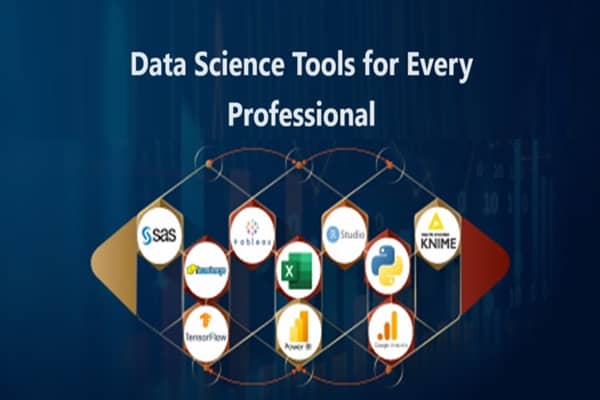In today’s fast-paced professional world, data science stands as a beacon of progress, propelling innovation and streamlining processes across a multitude of industries. It’s the alchemy of converting the lead of raw data into the gold of actionable insights that positions data science as a cornerstone of modern business strategy. The potency of this discipline is largely drawn from an arsenal of sophisticated tools; these are the instruments that enable professionals to sift through the digital chaff to reveal patterns, trends, and solutions that inform critical business decisions.
The significance of data science tools extends beyond mere data analysis; they represent a bridge between the vast oceans of data and the terra firma of business intelligence. As we delve into the array of tools that form the data scientist’s toolkit, from data collection to machine learning, we uncover the indispensable allies of any data-driven professional. These tools are not just facilitators of data manipulation but are the very gears that turn the wheels of insight generation, driving businesses towards a future where data-informed decisions are the keystones of success.
Contents
Data Collection and Management Tools
The first step in the data science pipeline is the collection and management of data. This stage is crucial as the quality of data directly influences the outcomes of any analysis.
- Web Scraping Tools: Tools like Beautiful Soup for Python and Octoparse allow professionals to extract data from web pages automatically. These tools are essential for gathering data from the internet, which can then be used for various analyses.
- API-based Tools: Postman is an example of a tool that simplifies the process of sending requests to APIs to retrieve data. It’s user-friendly and supports various methods, which makes it a favorite among developers and data scientists alike.
- Database Management Systems: SQL-based systems such as MySQL are fundamental for querying structured data. NoSQL systems like MongoDB are more suited for unstructured data, offering flexibility in data storage and retrieval.
- Data Warehousing Solutions: Solutions like Amazon Redshift provide a centralized repository for data, which can be used for extensive analytical computations and to generate complex queries.
- Data Cleaning Tools: Data rarely comes clean. Tools like OpenRefine and ETL platforms such as Talend help clean, transform, and enrich the data before it can be used for analysis.
Data Analysis and Processing Tools
Once the data is collected and cleaned, the next step is to analyze it to extract meaningful information.
- Statistical Analysis Software: R, with its packages like dplyr, and Python, with libraries such as Pandas and NumPy, are the leading languages for statistical analysis. They offer a range of functionalities, from basic descriptive statistics to advanced modeling.
- Spreadsheet Tools: For those less inclined to program, Microsoft Excel and Google Sheets are potential tools for performing various data analysis tasks. They are particularly useful for quick data manipulations and visualizations.
- Advanced Analytics Platforms: For more sophisticated statistical analysis, platforms like SAS and IBM SPSS are equipped with advanced features that cater to complex data analysis needs.
In the rapidly evolving landscape of data-driven decision-making, enrolling in a comprehensive data science course can empower professionals to harness the full potential of their insights.
Data Visualization Tools
Data visualization is a powerful way to communicate findings and make the data more accessible.
- Interactive Dashboard Tools: Tableau and Microsoft Power BI enable the creation of interactive dashboards. These tools are user-friendly and can handle large datasets, making them ideal for professionals who need to present data in an engaging way.
- Graphing Libraries: For those who code, Python’s Matplotlib and Seaborn, as well as R’s ggplot2, offer extensive capabilities for creating static, animated, and interactive visualizations.
- GIS Tools: For spatial data analysis, GIS tools like QGIS and ArcGIS are essential. They allow for the mapping and analysis of geographic data, which is crucial for many fields, such as urban planning and environmental science.
Machine Learning and Predictive Analytics Tools
Machine learning is a sub-field of artificial intelligence that focuses on building systems that learn from data, discovering patterns, and making decisions with minimal human intervention.
Machine Learning Libraries: scikit-learn for Python and CARET for R are comprehensive libraries that provide algorithms for creating machine learning models. They are integral for professionals looking to delve into predictive analytics.
- Deep Learning Frameworks: For more complex tasks that involve large amounts of data, deep learning frameworks like TensorFlow and PyTorch are the tools of choice. They are powerful in handling neural networks and are popularly used in image and speech recognition tasks.
- AutoML Tools: Google AutoML and DataRobot democratize machine learning by automating the process of applying machine learning models. They are particularly useful for professionals who may not have a deep background in machine learning.
Big Data Processing Tools
With the exponential growth of data, the ability to process big data has become a necessity.
- Distributed Computing Frameworks: Apache Hadoop and Apache Spark are designed for distributed storage and processing of large data sets across computer clusters. They are essential for professionals dealing with big data.
- Real-Time Data Processing Tools: Apache Kafka and Apache Flink offer solutions for processing data streams in real-time. They are crucial for businesses that require immediate insights from their data, such as in financial trading or online retail.
Data Science Collaboration and Version Control Tools
Collaboration and version control are vital in ensuring the integrity and reproducibility of data science projects.
- Collaboration Platforms: GitHub and GitLab are not just for version control; they also facilitate collaborative coding, issue tracking, and feature requests, making them indispensable for team-based data science projects.
- Project Management Tools: JIRA and Trello are project management tools that help data science teams organize tasks, track progress, and manage workflows efficiently.
Cloud-Based Data Science Tools
The cloud has revolutionized the way data science is done by providing scalable resources on demand.
Cloud Platforms: AWS, Microsoft Azure, and GCP offer a range of services, from data storage to machine learning capabilities. They allow professionals to access powerful computing resources without the need for extensive upfront investment in hardware.
Integrating Data Science Tools into Professional Workflows
The strategic incorporation of data science tools into professional workflows marks a pivotal step in leveraging the full potential of data-driven insights. This integration demands a nuanced understanding of the business’s unique challenges and objectives, as well as a thorough assessment of the team’s skill set. It’s a deliberate process, aligning the power of data science with the company’s vision, ensuring that every analytical tool and model is tailored to propel the business forward. Continuous education is the fuel for this engine, with professionals needing to engage in ongoing learning through online data science courses and tutorials to maintain a competitive edge. Staying updated with the latest data science technological advancements in data science tools is not just beneficial; it’s imperative for adapting to the ever-evolving landscape of data analytics.
- Strategic Alignment: Tailoring data science tools to meet specific business objectives and complement team strengths.
- Continuous Education: Embracing online learning resources to keep pace with the rapidly advancing field of data science.
Also read: Here’s What an Online Coding Class Really Needs
Conclusion
Data science tools are the engines that power the analysis and interpretation of data in the modern world. For professionals, these tools are not just about handling data; they are about unlocking the potential of data to inform decisions, drive innovation, and create value. As the field of data science continues to evolve, so too will the tools, ensuring that professionals who stay informed and skilled will lead the charge in the data-driven future.




